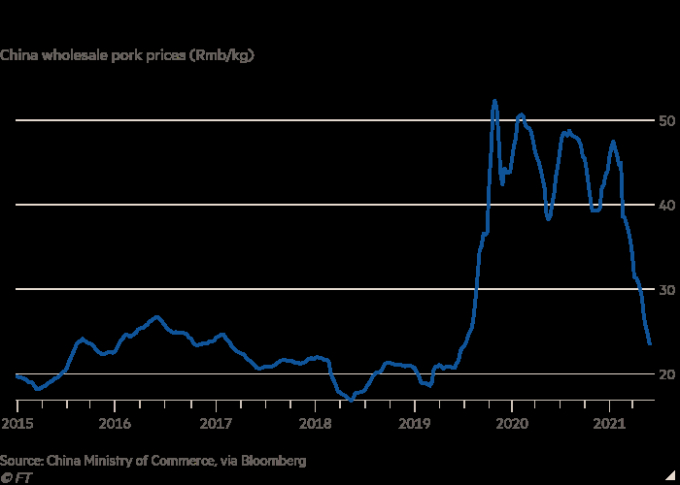November 27, 2025 | 04:47 GMT +7
November 27, 2025 | 04:47 GMT +7
Hotline: 0913.378.918
November 27, 2025 | 04:47 GMT +7
Hotline: 0913.378.918
Hog futures in China have fallen to record lows as mass slaughtering of pigs prompts fears that the world’s second-biggest economy faces a deluge of pork.

Wholesale pork prices in China have dropped almost 50% this year © Bloomberg
Rising concerns that the local pork market is becoming inundated have led to a more than 30 per cent fall in Dalian-traded hog futures, which allow investors to bet on the future direction of prices, since they were launched in January.
The situation contrasts with that in the world’s biggest producer, consumer and importer of pork over much of the past two years, when outbreaks of African swine fever resulted in price surges on fears of supply shortfalls.
Prices have been hit as authorities have encouraged farmers to raise more pigs and replenish the country’s pork reserves following outbreaks of ASF.
Analysts said that the situation had been made worse by farmers, concerned that prices will fall further, bringing forward plans to cull their herds. Oversupply fears have also been stoked by some farmers fattening their sows to weights of up to 300kg-400kg — comparable with some polar bears — versus their usual 200kg, according to Chinese media reports.
On Tuesday, hog futures on the Dalian Commodity Exchange dropped as much as 7.1 per cent to a trough of Rmb18,550 ($2,900) per metric tonne after it was reported that smaller pigs were also being slaughtered, adding even more supply.
Wholesale pork prices in China have dropped almost 50 per cent this year to Rmb23.57 per kilogramme, their lowest price since late 2019.

“It’s definitely surprising how fast and far pork prices have fallen,” said Darin Friedrichs, an analyst at commodities broker StoneX Group in Shanghai.
China has struggled to get a grip on pork price fluctuations since ASF began tearing through the country’s hog herds in 2018.
Analysts said the latest drop in futures prices was partly a response to a report issued by Beijing’s Xinfadi market, a large wholesale market in the capital, on Friday that noted that smaller pigs were being brought for sale.
This “indicates some farms have significantly lowered their expectations for future meat prices and . . . are slaughtering ahead of schedule”, according to the report.
The latest price swings prompted China’s cabinet, the National Development and Reform Commission, to publish a policy statement last week promising to “maintain supply and stabilise prices in the pork market”, without specifying what the measures were.
Pork prices are a significant component in China’s consumer price index, and their volatility has been a driver of its performance over the past year. Falling pork prices late last year helped push inflation into negative territory for the first time in over a decade.
Friedrichs, at StoneX, said policymakers had hoped the introduction of futures contracts would help smooth out boom and bust cycles in Chinese pork prices.
“Now we’re in a bust cycle, so the volatility is still there,” he said.
(Finacial Times, Bloomberg)

(VAN) A new study reveals how the simultaneous effects of ocean acidification, salinity and loss of oxygen are making the world more fragile.

(VAN) Hopes are growing that the creation of the first 3D turkey gut model could be a turning point in the battle against the virulent blackhead disease.

(VAN) Tyson, America’s biggest meat supplier, plans to shutter one of its largest beef processing plants as the industry continues to struggle with low cattle supplies and political pressure from Washington.

(VAN) New FAO study shows how digital solutions are empowering farmers and fishers to prevent losses and build resilient agrifood systems.

(VAN) Brazil's COP30 presidency pushed through a compromise climate deal on Saturday that would boost finance for poor nations coping with global warming but that omitted any mention of the fossil fuels driving it.

(VAN) Poultry farmers in the UK have been warned that they could face one of the worst winters yet for bird flu.

(VAN) Prices of main-crop paddy have risen sharply, with jasmine rice hitting 16,100 baht per tonne — the highest level in years.